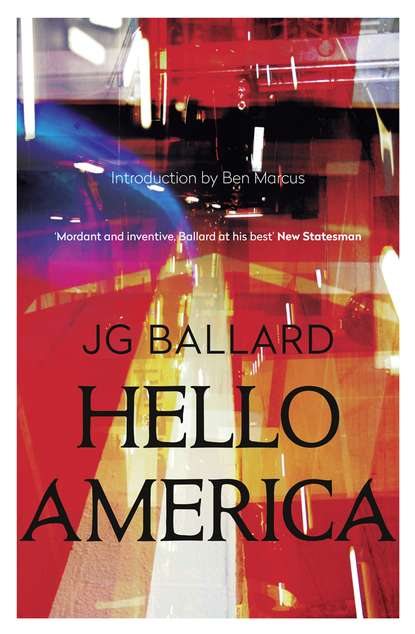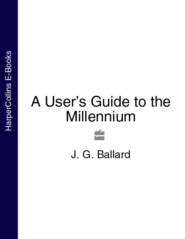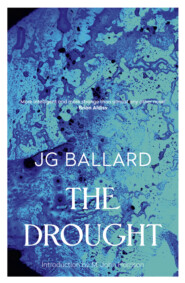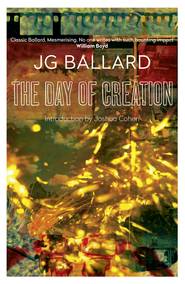По всем вопросам обращайтесь на: info@litportal.ru
(©) 2003-2024.
✖
Hello America
Автор
Год написания книги
2018
Настройки чтения
Размер шрифта
Высота строк
Поля
Wayne followed at their heels, eager to get away. He looked back at Steiner, who waved him ahead, pointing towards the city. The Captain’s complex motives unsettled him. As Anne Summers paused to shake the sand from her shoes, he darted between her and Ricci.
‘Wayne!’ Orlowski caught his arm. ‘Don’t touch anything! You’re a stowaway, remember. You’ve no official status in this hemisphere.’
Laughing, Wayne pulled away from him. For the first time he felt on equal terms. ‘Gregor, come on! There’s the whole of America here.’
He sprinted ahead to the great dunes which spilled from the riverside streets across the dock basin. The bright sand came towards him, its warm flank glittering in the sunlight, a golden breast on to which he threw himself happily.
For the next heady but confusing hours they carried out their first foray into the empty city. As Wayne trudged down the airless, dune-filled canyon that had once been Seventh Avenue, he soon discovered that if any streets in America were paved with gold it was not here in Manhattan. The golden carpet that seemed to cover the city with a treasure beyond the dreams of the conquistadores had been a complete illusion. As he listened to the distant shouts of the sailors, and the breaking plate glass of bars and stores, he realised that he was surrounded by a wilderness of sand, a harsh bronze dust heated by a relentless sun.
He was standing in the ash pit of a huge solar furnace. Wayne felt sorry for McNair, but the illusion had served its purpose, left a striking memory in all their minds of their first sighting of America. At the same time, the golden glare around him was a sharp reminder of all his own misapprehensions. Wayne had expected to find the streets lined with brightly gleaming cars, those Fords, Buicks and Chryslers whose extravagant styling he had studied in the old magazines, symbols of the speed and style of the United States and archetypal villains of the energy crisis.
But the dunes were at least ten feet deep, reaching up to the second floors of the office buildings. Half the Appalachians had been destroyed by the sun to yield this deluge of rock and dust. Street signs and traffic lights protruded from the sand, a rusty metallic flora, old telephone lines trailed waist-high, marking out a labyrinth of pedestrian catwalks. Here and there, in the hollows between the dunes, were the glass doors of bars and jewellery stores, dark grottoes like subterranean caves.
Wayne plodded along Broadway, past the silent hotels and theatre façades. In the centre of Times Square a giant saguaro cactus raised its thirty-foot arms into the overheatedair, an imposing sentinel guarding the entrance to a desert nature reserve. Clumps of sage-brush hung from the rusting neon signs, as if the whole of Manhattan had been transformed into a set for the ultimate western. Prickly pear flourished in the second-floor windows of banks and finance houses, yucca and mesquite shaded the doorways of airline offices and travel agents.
At the intersection of Fifth Avenue and 57th Street, Wayne paused to catch his breath from the effort of climbing the sand-hills. As he leaned against the dusty eyes of a traffic light there was a sudden armoured flicker from the half-submerged neon display on a building twenty feet behind him. From the shadows emerged a small but plainly venomous lizard—a gila monster inspecting the blundering young man as possible prey.
Wayne kicked the fine sand into its face and set off at a run. On all sides was a secret but rich desert life. Scorpions twitched like nervous executives in the windows of the old advertising agencies. A sidewinder basking in a publisher’s doorway paused to observe Wayne approach and then uncoiled itself in the shadows, waiting patiently among the desks like a merciless editor. Rattlesnakes rested in the burrow-weed on the window-sills of theatrical agents, clicking their rattles at Wayne as if dismissing him from a painful audition.
Wayne pressed on towards Central Park. Already he could see the hundreds of giant cacti that stood in ranks down the length of the park, transforming this once green rectangle into a desert replica of itself, a red ochre wilderness shipped from Arizona and lowered down from the sky. Drenched in sweat, he looked round wistfully for one of the water hydrants that were part of the folklore of summer New York. At intervals, following the routes of the subway system, the sea had seeped in through storm-drains and sewers. Groves of miniature tamarisks and creosote bushes sprang from the underground car-parks of the great hotels, salt grass and paloverde choked the sand-filled concourse of Rockefeller Plaza.
Searching for something to drink, Wayne turned back along Fifth Avenue. He climbed a shallow dune and stepped through an open window into the second floor of a huge department store. Sand lay in drifts among the suites of furniture and barbecue equipment. A tableau family of well-dressed mannequins sat around a dining-room table, gazing politely at the waxwork meal laid in front of them, oblivious of the fine sand, the dust of past time, that covered their faces and shoulders.
Deciding to return to the Apollo, Wayne set off down the Avenue, picking his way among the cooler hollows and saddles. Already he felt slightly disappointed, as if someone had reached New York just before him and stolen his dream. Besides, there was something macabre about this empty metropolis overrun by sand. The ancient desert cities of Egypt and Babylonia were safely distanced from them by the span of millennia. But for all its rusting neon signs, the New York around him seemed preserved in limbo, its vast buildings abandoned only the previous day.
Pausing to rest again, Wayne stepped into the second floor of a large office block, a long shadowy promenade on which hundreds of desks stood in lines, each with a telephone and typewriter, as if occupied at night by a phantom regiment of secretaries. Thinking of the Fleming expedition, he lifted one of the receivers, almost expecting to hear the warning voice of his long-lost father, urging him back to the safety of Europe.
Light flared in the street outside. As Wayne hid behind the window pillar a golden figure appeared on the crest of the nearest dune, a creature with gilded arms and blazing beard. It gazed around like a deranged animal, kicking at the dust.
‘McNair!’ Wayne leapt through the window and ran forward. ‘McNair, it’s all right!’
The engineer was covered with the bright sand. An almost metallic film had caked itself into the mud on his beard, shirt and trousers. He greeted Wayne with a weary wave.
‘Hello, Wayne, what do you think of America? Find any gold, by the way? We were going to be rich, load the Apollo with a cargo of El Dorados, trade the damned stuff in for a few machine tools and a lick of paint. It’s rust, Wayne, the rust of a hundred years…’
Wayne pointed to the western horizon. ‘McNair, we can still find gold, and silver. There’s the whole of America over there.’
‘Good for you.’ A cracked golden smile parted McNair’s lips. ‘We’ll fit the Apollo with wheels and sail her to the Rockies.’
He gave an ironic salute to a man on horseback, braided cap over his sunglasses, who had appeared from behind the giant cactus at the street junction beside them. ‘Did you hear that, Captain Steiner? Are you ready to cast off? We’re setting sail for the gold coast, westwards on the first tide…’
With a wild lunge he kicked up a spray of sand, then nodded at the eventless blue sky and silent streets, ready to attack anything that moved.
Steiner approached at a leisurely pace, gently urging his black mare up the slope. His dark face was expressionless behind the sunglasses. Looking up at him, Wayne reflected that for all his nautical gear Steiner seemed more at home on his horse than on the bridge of the Apollo. The heat and the desert light, the unsettled mare churning the hot sand with a nervous hoof, the great cactus at the Captain’s shoulder, together made Steiner resemble some plainsman of the Old West.
‘This tide won’t ebb, McNair – not for a million years, anyway. Let’s get back to the ship. Help him, Wayne.’
A coiled rope hung from his saddle. Had he been stalking McNair through the dusty streets, waiting to lasso and truss the engineer like a wayward steer overexcited by its own shadow? As they returned to the Apollo, Wayne watched the Captain with renewed respect. Groups of sailors were making their way back, some drunk on looted whiskey, kicking their overstuffed suitcases. One man dragged by its artificial hair a fibre-glass mannequin of a naked woman, a department store dummy of a kind unknown for years in clothes-rationed Europe. Orlowski waited at the Cunard pier, amicably fanning his face with a newly acquired Stetson. Ricci was complaining in a bad-tempered way at Anne Summers, who struggled gamely through the sand, one hand on her unravelling bun, this slipping granny knot that would let loose her concealed American self.
Secure on his horse, Steiner moved behind them all, waiting until they were safely aboard, as if about to abandon them there and set off alone across the inland sea of the empty continent.
6 The Great American Desert (#ulink_d7a4c3e4-8f87-58ea-bcf9-8fe9d87adefa)
At seven o’clock that evening, when the air at last began to cool, a small reconnaissance party set out through the shaded streets to the north-western perimeter of the deserted city. Steiner rode by himself in the lead, followed by Orlowski and Anne Summers, with Wayne taking up the rear on a little palomino. Ricci had stayed behind, fuming in his cabin after an altercation with the Captain, who had caught him smuggling aboard a heavy automatic pistol he had looted from a gunsmith’s.
Manhattan was silent, the huge buildings withdrawing into their emptiness as the sun moved across the western land. They passed the George Washington Bridge, and then paused to look out over the mile-wide channel of the Hudson River.
In front of them was an unbroken expanse of sand strewn with sage-brush, a dusty plantation of cacti and prickly pear. A century earlier the Hudson had dried up, and was now a broad wadi filled with the desert flora that had come in from New Jersey. The harsh and glaring light of the early afternoon had given way to the red earth colours of evening. They stood silently by their horses at the edge of the half-buried expressway. Beyond the Jersey shore Wayne could see the rectangular profiles of isolated buildings, their sunset façades like mesas in Monument Valley. Already they had arrived at an authentic replica of Utah or Arizona.
Nearby was a small six-storey office block whose glass doors had long ago been smashed by vandals. After tethering their horses, they climbed the stairway around the elevator shaft to the roof. Together they looked out over the empty land, like prospective purchasers offered a wilderness for sale.
‘It’s a desert…‘In a gesture of respect, Orlowski took off his Stetson and held it against his plump chest. ‘Nothing but desert, probably all the way to the Pacific’
Anne Summers shielded her eyes from the sun’s disc, now bisected by the horizon. The vermilion glow gave her face a flush of animation, as if she were a convalescent already showing a marked improvement on the first day of arrival at a desert resort. Without thinking, she touched Wayne’s shoulder, concerned for the young stowaway’s sake.
‘It’s strange, and yet familiar at the same time. I feel I’ve been here. Gregor, we knew the climate had changed.’
‘But not like this. This is like the Sahara in the twentieth century. It’s going to affect the mission—we aren’t equipped for this sort of terrain. What do you say, Captain?’
Steiner had removed his sunglasses and was staring out across the dried river. His deeply tanned face had become more hawk-like, his eyes had moved back into their sockets under the weathered overhang of his forehead.
‘I don’t agree, Commissar,’ he replied calmly. ‘It’s all that much more of a challenge. Do you understand, Wayne?’
Wayne understood all too well. The next morning, as Orlowski and Anne Summers supervised the transfer ashore of the expedition’s stores, Wayne joined the party of armed sailors who explored the area around New York. Led by Steiner, they rode ten miles out into the desert, a sunbaked wilderness that stretched as far as the Catskills and almost certainly well beyond them. Here and there, in Jonkers and the Bronx, they came across a freshwater spring in a highway culvert, or a few shabby date palms reared from the cracked floor of a motel swimming-pool. But these small oases were clearly too few to sustain a long expedition inland.
This sight of the failed continent only served to spur Steiner on – his long-dormant resources for surviving in this arid world were now emerging. Yet all of them were strongly affected by the sight of this once powerful nation lying derelict in the dusty sunlight. They rode through the silent suburbs of uptown New York, across the precarious hulk of the Brooklyn Bridge to Long Island, and over the bleached ghost of the Hudson to the Jersey shore. The endless succession of roofless houses, deserted shopping malls and sand-covered parking lots was unsettling enough. Resting from the noon glare, Wayne and the sailors wandered through the abandoned supermarkets, whose shelves were still loaded with the canned goods no one had been able to cook. They climbed to the top floors of lavishly furnished apartment houses that had become freezing tenements in the North American winter. Everywhere the desert had moved in, cacti thrived in the shaded forecourts of fortified filling stations, creosote bushes had taken over the suburban gardens. At Kennedy Airport hundreds of abandoned airliners sat on flattened tyres, mesquite and prickly pear grew through the wings of parked Concordes and 747s.
All around them, as well, was ample evidence of the desperate attempts by the last Americans to beat the energy crisis. Within this once heroic landscape of giant highways, factories and tower blocks there existed a second shabby world of metal shanties fitted with wood-burning stoves, pathetic home-made solar-power units rigged to the roofs of modest houses like ambitious conceptual sculptures, ramshackle water-wheels whose blades were locked for ever now in sand-clogged streams. Thousands of makeshift windmills had been erected in back yards and drive-ways, their metal blades cut from the shells of refrigerators and washing machines. And even more ominously, the quiet streets of Queens and Brooklyn were filled with fortress-like gas stations, government water depots built like block-houses, gun-slits still visible among the crumbling sandbags.
And everywhere, to Wayne’s relief, there were the cars. They sat nose to rear bumper in the dust, rusting shells transformed into metal bowers for the wild flowers that sprang through the broken windshields, their engine compartments a home for kangaroo rats and gophers.
It was the cars that most surprised Wayne. His childhood in Dublin had been fed by dreams of an America filled with automobiles, immense chromium mastodons with grilles like temple façdes. But the vehicles he found in the streets and suburbs of New York were small and cramped, as if they had been designed for a race of dwarfs. Many of them had been fitted with gas cylinders and charcoal burners, others were antique steam-driven contraptions with grotesque pipes and compression chambers.
When Steiner and the sailors returned to the Apollo, Wayne dismounted outside a sand-filled automobile showroom on Park Avenue. He spent the hot afternoon digging away a huge dune that had rolled in across the display vehicles, preserving their still bright chromium and paintwork. He pulled back the door of one of these miniature vehicles, a Cadillac Seville only six feet long. He sat at the cramped controls, reading the admonitory instructions below the General Motors medallion, the warnings against excessive acceleration, speeds above thirty miles an hour, unnecessary braking.
Wayne cried out, laughing at himself. Where were the Cadillacs and Continentals of yesteryear? Into what exile had vanished the true Imperial splendour?
7 The Crisis Years (#ulink_6991db3c-05c1-5691-a733-f97ae20261a4)
Reluctant to sleep, they sat late into the night on the deck of the Apollo, crew and passengers together. Under the pleasant glow of the rigging lights, Wayne listened to Orlowski, Steiner and Anne Summers discuss their revised plans for the expedition. After two days in New York, they were still laboriously trying to make sense of the vast climatic upheaval that had denuded this once powerful and fertile land.
As Orlowski pointed out, the first ominous signs of the decline and fall of America had become apparent as early as the middle years of the twentieth century. Then a few far-sighted scientists and politicians had warned that the world’s energy resources—in particular, its oil, coal and natural gas—were being consumed at an ever-increasing rate that would exhaust all known reserves well within the lifetimes of their own grandchildren. Needless to say, these warnings were ignored. Despite the emergence of vocal ecology and soft technology movements, the industrialisation of the planet, and especially of the developing nations, continued apace. However, by the 1970s energy sources at last began to run out as predicted. The price of oil, hitherto a small and static fraction in world manufacturing costs, suddenly tripled, quadrupled and by the mid-1980s had risen twenty-fold. An internationally coordinated search for new oil reserves provided a brief respite, but by the 1990s, as the industrial activity of the United States, Japan, Western Europe and the Soviet bloc continued unchecked, the first signs of an insoluble global energy crisis began to appear.
Unable to pay the vastly increased price for imported oil, a number of once thriving economies abruptly collapsed. Egypt, Ghana, Brazil and the Argentine were forced to cancel huge programmes of industrialisation. The ambitious Western Sahara irrigation project was abandoned, the Upper Amazon dam left uncompleted. The construction of the vast new port complex at Zanzibar, which would have made it the Rotterdam of Central Africa, was halted overnight. Elsewhere, too, the effects were equally unsettling. At the orders of the French and British governments, work ceased on the Cross-Channel Bridge. The approaching arms of the two immense systems of linked suspension bridges were then separated by only a single mile of open water, but since the exhaustion of the North Sea oil and gas fields in the last years of the 1980s it had become clear that the huge volume of road traffic anticipated would never materialise.
All over the world industrial production began to falter. Stock markets slumped, avalanching numerals in Wall Street, the Bourse and the City of London showed all the signs of an even greater recession than the 1929 Crash. By the mid-1990s the automotive giants of the United States, Europe and Japan had cut car production by a third. As armies of workers were laid off, hundreds of component manufacturers were forced into bankruptcy, factories closed, dole queues formed in once prosperous suburbs. For the first time in more than a century, demographers noticed a small but significant drift from town and city back to the countryside.
In 1997 the last barrel of crude oil was pumped from an American well. The once huge reservoirs of petroleum which had fuelled the US economy throughout the twentieth century, and made it the greatest industrial power ever known, had at last run dry. From then on, America was forced to rely on an increasingly scarce supply of imported oil. But the planet’s main reserves, in the Middle East and the Soviet Union, were themselves almost exhausted.










